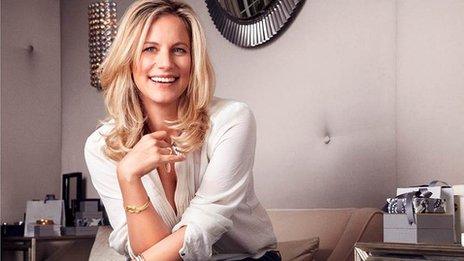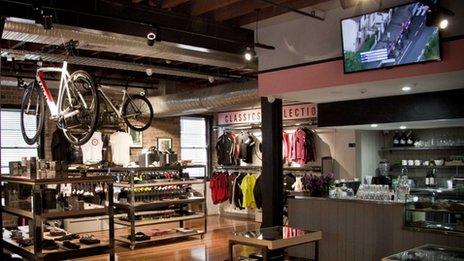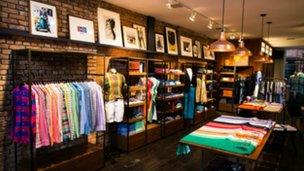Online retailers move into bricks and mortar stores
- Published

Having a High Street store is important because it gives shoppers a choice, says Bec Clarke
With the inexorable rise of online shopping, there have been gloomy predictions about the future of the bricks and mortar, High Street store.
Yet it seems that reports of its imminent demise may have been exaggerated.
In a new twist, established e-commerce businesses are increasingly opening physical stores.
This emerging trend, labelled "clicks to bricks" or "e-tail to retail", looks set to inject some much-needed vigour back into local High Streets.
A recent survey in the United States of the shopping habits of 18- to 25-year-olds, external suggests that just over two thirds of them - some 68% - prefer to shop in stores for clothing and shoes.
"Retail observers have been significantly overestimating our use of online and digital technology for shopping - we like shopping in stores," says Nicole Flasch-Mihalko of LIM College, which carried out the survey with the National Retail Federation in the US.
Online brands are now acting on this.
In the UK, menswear brand Orlebar Brown, whose swimming shorts Daniel Craig famously sported in the James Bond movie Skyfall, has recently opened three London stores.
A physical store offers shoppers the chance to touch, feel and try on merchandise, and for luxury brands in particular, this is important.
Engineering connections
For instance, Rapha, which started as an online business in 2004 selling high-performance cyclewear, opened its first store or Cycle Club in San Francisco in 2011.
Now it also has branches in London, Osaka, New York and Sydney.
Rapha says its stores have been a big hit with customers, offering a showcase for its clothing but also acting as a place to absorb cycle culture - to drink coffee, join in organised cycle rides and watch major races on big screens.
"The Cycle Clubs are conceived as meeting places for road racing fans and great places for like-minded people to hang out," says Rapha's chief executive Simon Mottram.
"Rapha is the host of these places and it's great for us to engineer connections between customers, not just between the customer and brand."
And he says its stores are also helping Rapha to better understand its customers.
"It's hard for brands to engage with their customers in a purely digital way.

Rapha wants its shops to be more than just places for cyclists to buy spare inner tubes
"That may be fine if your business is only about conducting simple transactions, but if you want to truly connect with a customer and create a deep, ongoing relationship with them, then a physical experience is invaluable.
"Many people like to shop in bricks and mortar locations. There is the possibility of theatre and human interaction there - these things shouldn't be underestimated."
There is a new model of retailing emerging, "with brands having a core website that covers the majority of purchases", he says.
"With a number of high-touch, physical 'brand experiences' on top of that platform - allowing the customer to really engage with the brand."
'It's a whole journey'
For Bec Clarke, founder and chief executive of jewellers Astley Clarke, it is all about "allowing customers to shop how they want".
Her firm has seen rapid online growth, and has now opened a showroom and store at its London headquarters - as well as supplying a number of UK department stores.
Within the next few months it also plans to supply several major stores in the United States.
"There's a long consideration process to buying jewellery," Clarke explains, as we sit on plush sofas in her firm's showroom, the decor complete with mirrored furniture and luxuriant cream padded walls.
"It's a whole journey of trying on and thinking about it and trying on again, and we have to allow the customer to go on that journey," she says.
"It's also important for our bespoke service - clients like to see and touch the gemstones.
"The heart of our business is online, but we have a 'channel agnostic' approach, which is where the world is moving to."
'Create a storm'
For High Street landlords with vacant space to rent as well as online start-ups this trend is good news, says Ross Bailey, founder and chief executive of Appear Here.
His firm brings together shop landlords and mainly e-commerce entrepreneurs, with the aim of making renting a pop-up or permanent physical shop easier and more flexible.

Bonobos allows shoppers to try on items and then order online
"Pop-ups helps fill in any awkward pauses that a landlord may have, and it's good for brand building, too," he says.
"It can be hard and expensive to get noticed online now.
"But if you spring up offline - even for a short time - shoppers will love the interaction and share their experience of going there by tweeting or sharing an image online.
"You can create a storm."
Blurring boundaries
Some e-commerce brands are moving into so-called guide shops - allowing shoppers to try on items, and then order in-store for home delivery.
Bonobos menswear is at the forefront of this phenomenon, and has opened guide shops across the United States. Increasingly it seems, the channels are blurring.
Bonobos founder and chief executive Andy Dunn argues that this is the future of retailing, but that "it is also the past".
"When you look at retailers who are thriving in this environment, it's the brands focused on delivering a strong service experience.
"It is one of the ironies of our time that a digital medium, the internet, is making the in-person shopping experience a more humane one," he says.
- Published24 September 2013
- Published11 September 2013